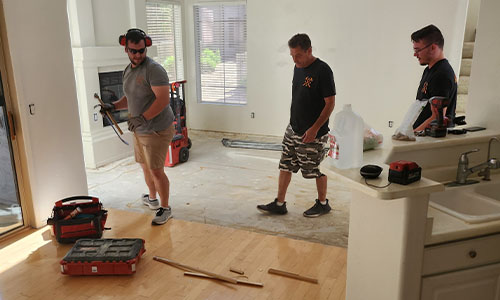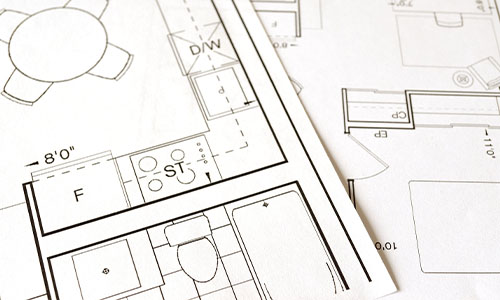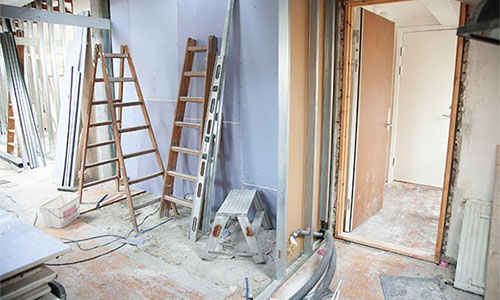Table of Contents
Remodeling Tips for Effective Planning & Execution
Remodeling is more than just a structural change; it’s a meticulous endeavor where your vision harmonizes with architectural expertise. Each decision made, from the choice of materials to the layout design, significantly influences the outcome.
Tip #1: Set Goals
In the intricate process of remodeling your home, precision and planning are key. Before diving into blueprints and construction, take a step back and make a list—a comprehensive inventory of your needs and wants. Your needs are the fundamental elements essential for your daily life, while your wants are the delightful enhancements that could make your space truly special.
- Are there any structural changes that need to happen?
- Which appliances do you want?
- Are there any aesthetic upgrades you would like to make?
Once you’ve listed your needs and wants, the next step is prioritization. Imagine this list as a roadmap, guiding you through the remodeling journey. Begin by ranking your needs. What aspects of your living space are indispensable? These could be structural repairs, safety upgrades, or functional improvements that directly impact your daily routine. Assigning priority to these non-negotiable elements ensures they are addressed, regardless of budget constraints.
After establishing your needs, turn your attention to your wants. These could be aesthetic upgrades, luxurious additions, or features that would enhance your overall comfort.
Rank these in order of importance. What would significantly elevate your living experience? By organizing your wants by priority, you create a flexible framework. If your budget doesn’t encompass every desire, you’re prepared to make informed decisions. This strategic approach ensures that your remodel aligns with your vision, even if adjustments are necessary. Remember, a well-ordered list isn’t just a planning tool; it’s a powerful way to transform your dreams into a carefully tailored reality.
Tip #2: Research the Cost

Embarking on a remodeling project without a clear understanding of the financial landscape is akin to setting sail without a compass. In the realm of home improvement, researching costs is your compass, guiding you through the maze of expenses associated with materials, labor, permits, and unforeseen contingencies. Knowledge is your greatest asset in this endeavor.
Once you’ve delved into the cost intricacies, the next crucial step is to gather multiple quotes. Think of these quotes as different maps, each offering a unique route to your destination. Contact reputable contractors and request detailed quotes. These quotes serve as valuable benchmarks, allowing you to compare services, materials, and costs effectively.
Always get multiple quotes when estimating the cost of your remodel.
By obtaining multiple quotes, you gain a panoramic view of the financial terrain. You can discern fair pricing from inflated estimates and make informed decisions. It’s not merely about choosing the lowest quote; it’s about selecting the one that offers the best value—a blend of quality workmanship, reliable materials, and reasonable costs.
Tip #3: Build Your Budget

In the intricate dance of home remodeling, unexpected twists and turns are almost inevitable. As you meticulously plan your budget, it’s vital to reserve a contingency fund. Think of it as a financial safety net, a cushion designed to absorb the shock of unforeseen expenses and sudden changes in the project’s scope.
Always reserve 10-20% extra for unpredicted expenses.
Renovations, like life, can be unpredictable. Perhaps you uncover hidden structural issues, or you decide to upgrade a fixture unexpectedly. These surprises, while challenging, are far less daunting when you have a financial buffer in place.
A contingency fund offers you peace of mind. It transforms unexpected hurdles from financial crises into manageable challenges. With this safety net, you can navigate the twists and turns of remodeling with confidence, knowing that your budget is equipped to handle the unforeseen. Consider it not just an additional expense, but a strategic investment in the smooth progression and successful completion of your remodeling project.
Tip #4: Hire the Right Contractor

In the world of home makeovers, the person shaping your dream space matters a lot. Quality work, how well a job is done, is super important. The builder you choose isn’t just someone who does a job; they’re like an artist turning your ideas into something real.
To pick the right builder, think about what others say. Recommendations from people you trust—like family or friends—are like gold. They can tell you who’s good at the job. And online reviews, like comments on websites, also give you hints about how well a builder works.
Quality work matters a ton. It turns a plan into a real, livable home. Choosing a builder known for their excellent work isn’t just a choice; it’s like teaming up with an expert creator. When you have someone good at the job, your dream home becomes more than just a plan; it turns into a cozy, beautiful reality, made just for you.
Tip #5: Create a Design
In the realm of home remodeling, the guidance of experienced designers and architects stands as an unparalleled asset. Their expertise transcends the realm of aesthetics; it encompasses the meticulous fusion of functionality, beauty, and structural integrity. Collaborating with these seasoned professionals ensures that your vision transforms into a tangible masterpiece, reflecting your unique style and aspirations.

Why Experienced Designers Matter:
- Vision Realization: Experienced designers possess an innate ability to understand your vision deeply. They translate your ideas into detailed plans, ensuring that every element aligns with your expectations.
- Spatial Optimization: Design professionals possess a keen eye for spatial dynamics. They optimize your living areas, ensuring efficient utilization of space without compromising aesthetics. This skill is especially vital in smaller or oddly shaped spaces, where intelligent design can make a significant difference.
- Material Selection: Designers, well-versed in materials and their properties, guide you in choosing the most suitable options. From durable flooring to eco-friendly paints, their expertise ensures that your choices are not only visually appealing but also practical and sustainable.
- Budget Management: Contrary to common belief, working with a designer often aids in budget management. They help you make informed decisions, preventing unnecessary expenditures while ensuring high-quality outcomes.
- Problem-Solving: Experienced professionals anticipate challenges and offer creative solutions. Whether it’s adapting to structural limitations or enhancing natural lighting, their problem-solving skills guarantee a harmonious blend of form and function.
The Collaborive Process:
Collaborating with a designer or architect is akin to embarking on a co-creative journey. It begins with detailed consultations, where your ideas and aspirations are meticulously explored. Through sketches, 3D models, and architectural plans, your vision starts taking shape.
Moreover, these professionals act as liaisons between you and contractors, ensuring that the construction aligns seamlessly with the envisioned design. Their attention to detail extends from the placement of a light fixture to the harmony of color palettes, resulting in a space that not only meets but exceeds your expectations.
Tip #6 Choose Quality Materials
When it comes to remodeling, the materials you choose are the building blocks of your vision. Yet, the allure of convenience might lead you to settle for the first option that catches your eye. Resist this urge. Deliberation is key: consider maintenance, durability, and aesthetics meticulously. Here’s why these factors are pivotal and how involving a designer or contractor can be your wisest move.
Try to opt for higher quality materials. Long lasting materials pay off in the long-run.

Maintenance Matters: Selecting materials with low maintenance requirements not only eases your daily upkeep but also ensures the longevity of your investment. For instance, in high-traffic areas, robust and easy-to-clean flooring materials can withstand wear and tear, maintaining their beauty for years. Your designer or contractor can guide you toward choices that balance practicality with visual appeal.
Durability: Durability goes hand in hand with long-term value. Opt for materials that can withstand the tests of time, weather, and regular usage. Your surfaces should be resilient against scratches, stains, and the impact of daily life. A professional can direct you toward options that combine durability with style, ensuring your space remains exquisite even under the pressures of daily use.
Aesthetics: While aesthetics play a significant role, it’s not just about visual appeal. The right materials can enhance the ambiance of your home, evoking the desired atmosphere in each room. Consider the interplay of natural light and surfaces, or how textures influence the overall feel of a space. A designer’s expertise lies in understanding these nuances, helping you weave a harmonious tapestry of aesthetics, functionality, and comfort.
A Note on Consulting Professionals
When choosing materials, there are dozens of factors that play into making the best choice. Your contractor will have lots of experience with different materials, and they’ll be able to tell you which one’s last the longest, are easiest to maintain, and will complement the style you’re going for. Always talk to an expert before you lock in any decisions.
Tip #7: Create Your Timeline
A defined timeline acts as the backbone of your project. It establishes a structured plan, detailing the commencement and completion dates of each phase. Precision in scheduling ensures that tasks align seamlessly, preventing bottlenecks and unnecessary downtime. When you have a clear roadmap, you minimize uncertainties and streamline the entire process.
Planning will prevent bottlenecks where contractors are left waiting for other contractors to finish their work.
Prepare for Delays: In the world of construction and renovation, unexpected delays are almost inevitable. Unforeseen issues, weather conditions, or even regulatory approvals can extend the project duration. Hence, prepare mentally and practically for delays. Having a buffer in your schedule accommodates these unforeseen circumstances, minimizing stress and allowing for adaptability. Flexibility is key; it allows you to navigate challenges without compromising the quality of your project.
The Role of Strategic Planning: Effective time management isn’t just about hastening the project; it’s about strategic planning. A well-thought-out schedule allows for thoroughness and attention to detail, ensuring that every aspect of your remodeling endeavor receives the focus it deserves. Rushing can lead to oversights and compromises, impacting the overall quality of your project. Therefore, a meticulously planned timeline balances efficiency with precision, guaranteeing a flawless transformation.
Tip #8: Manage Dust and Dirt
Here’s why sealing off doorways and vents, along with strategic ventilation, are paramount in ensuring a clean and comfortable environment during your project.

Sealing Off Doorways and Air Vents: Dust and dirt have a knack for infiltrating every nook and cranny. To counter this, meticulously seal off doorways and air vents with plastic barriers. This practice not only prevents the spread of dust to other parts of your home but also ensures that confined spaces remain clean. By creating physical barriers, your contractor establishes controlled work zones, limiting the impact of construction activities on your living spaces.
Use plastic to seal off:
- Windows
- Doorways
- Air Vents
Strategic Ventilation: Proper ventilation is the cornerstone of a dust-free environment. While sealing off certain areas is essential, strategic ventilation through open windows plays a crucial role. It allows for the circulation of fresh air, diluting dust particles and maintaining a healthy atmosphere within the work area. Proper ventilation not only contributes to cleanliness but also promotes the well-being of everyone involved in the project, ensuring a comfortable and safe working environment.
It’s worth noting that your project will be much messier than you expect it to be. Be careful to seal up the construction area thoroughly, and don’t let pervasive dust cause harm to your health or home.
Don't be Afraid to ask for help!
Remodeling is a big undertaking. There’s a lot of different components to factor in, and it can be utter chaos if you don’t have help.
Reach out to us anytime! We’d love to help you plan and execute a beautiful remodel. You can call us at (623) 633-3318 for help, advice, or a quote!




